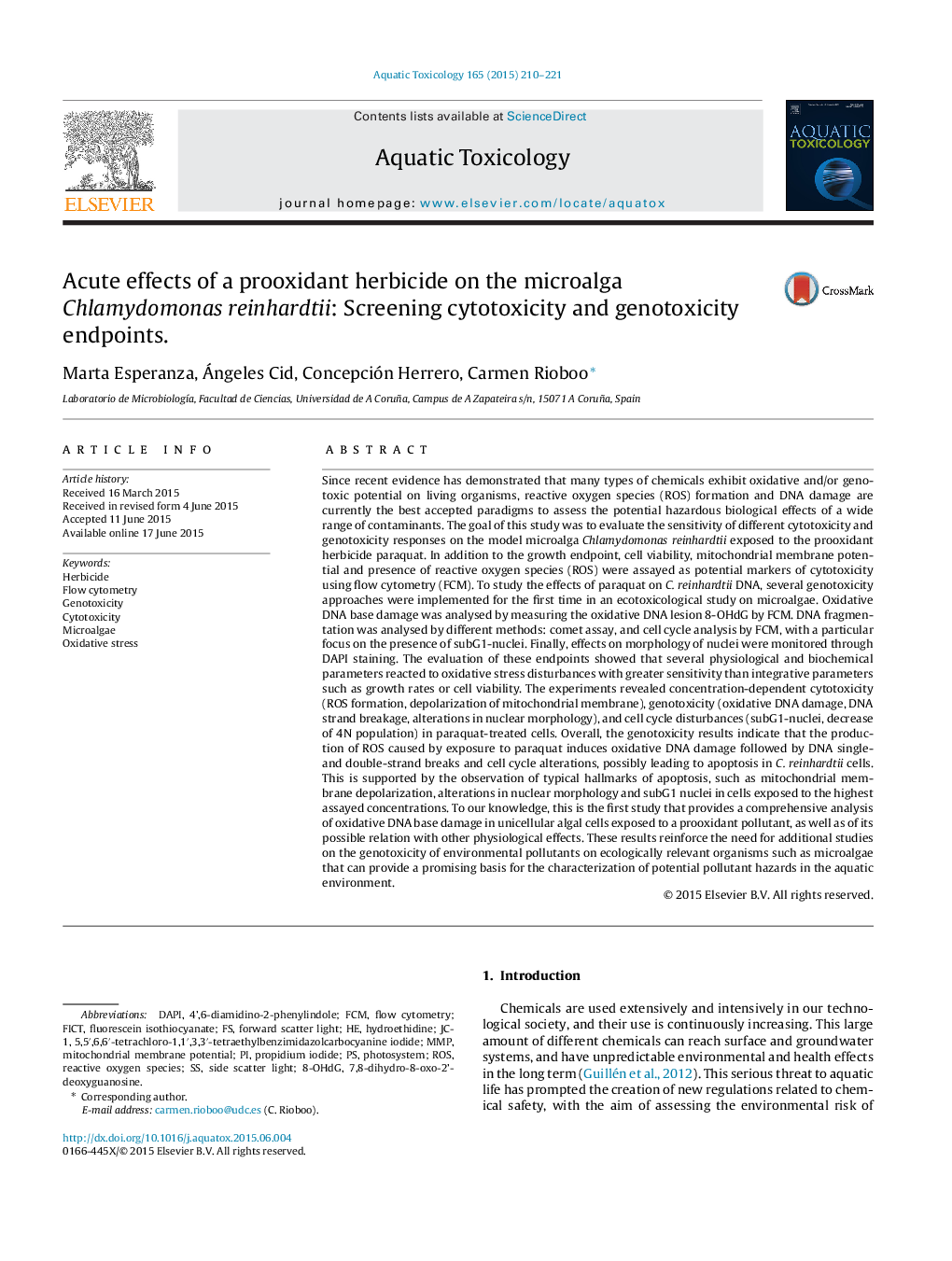| کد مقاله | کد نشریه | سال انتشار | مقاله انگلیسی | نسخه تمام متن |
|---|---|---|---|---|
| 4529027 | 1625940 | 2015 | 12 صفحه PDF | دانلود رایگان |

• Mitochondrial membrane potential constituted the most sensitive parameter assayed.
• Several genotoxicity methods were applied for first time in ecotoxicological studies.
• Oxidative DNA base damage (8-OHdG) was induced by paraquat exposure.
• Cells with DNA strand breakage and subG1-nuclei increased in treated cultures.
• Typical apoptosis hallmarks were observed in microalgal cells exposed to paraquat.
Since recent evidence has demonstrated that many types of chemicals exhibit oxidative and/or genotoxic potential on living organisms, reactive oxygen species (ROS) formation and DNA damage are currently the best accepted paradigms to assess the potential hazardous biological effects of a wide range of contaminants. The goal of this study was to evaluate the sensitivity of different cytotoxicity and genotoxicity responses on the model microalga Chlamydomonas reinhardtii exposed to the prooxidant herbicide paraquat. In addition to the growth endpoint, cell viability, mitochondrial membrane potential and presence of reactive oxygen species (ROS) were assayed as potential markers of cytotoxicity using flow cytometry (FCM). To study the effects of paraquat on C. reinhardtii DNA, several genotoxicity approaches were implemented for the first time in an ecotoxicological study on microalgae. Oxidative DNA base damage was analysed by measuring the oxidative DNA lesion 8-OHdG by FCM. DNA fragmentation was analysed by different methods: comet assay, and cell cycle analysis by FCM, with a particular focus on the presence of subG1-nuclei. Finally, effects on morphology of nuclei were monitored through DAPI staining. The evaluation of these endpoints showed that several physiological and biochemical parameters reacted to oxidative stress disturbances with greater sensitivity than integrative parameters such as growth rates or cell viability. The experiments revealed concentration-dependent cytotoxicity (ROS formation, depolarization of mitochondrial membrane), genotoxicity (oxidative DNA damage, DNA strand breakage, alterations in nuclear morphology), and cell cycle disturbances (subG1-nuclei, decrease of 4N population) in paraquat-treated cells. Overall, the genotoxicity results indicate that the production of ROS caused by exposure to paraquat induces oxidative DNA damage followed by DNA single- and double-strand breaks and cell cycle alterations, possibly leading to apoptosis in C. reinhardtii cells. This is supported by the observation of typical hallmarks of apoptosis, such as mitochondrial membrane depolarization, alterations in nuclear morphology and subG1 nuclei in cells exposed to the highest assayed concentrations. To our knowledge, this is the first study that provides a comprehensive analysis of oxidative DNA base damage in unicellular algal cells exposed to a prooxidant pollutant, as well as of its possible relation with other physiological effects. These results reinforce the need for additional studies on the genotoxicity of environmental pollutants on ecologically relevant organisms such as microalgae that can provide a promising basis for the characterization of potential pollutant hazards in the aquatic environment.
Journal: Aquatic Toxicology - Volume 165, August 2015, Pages 210–221